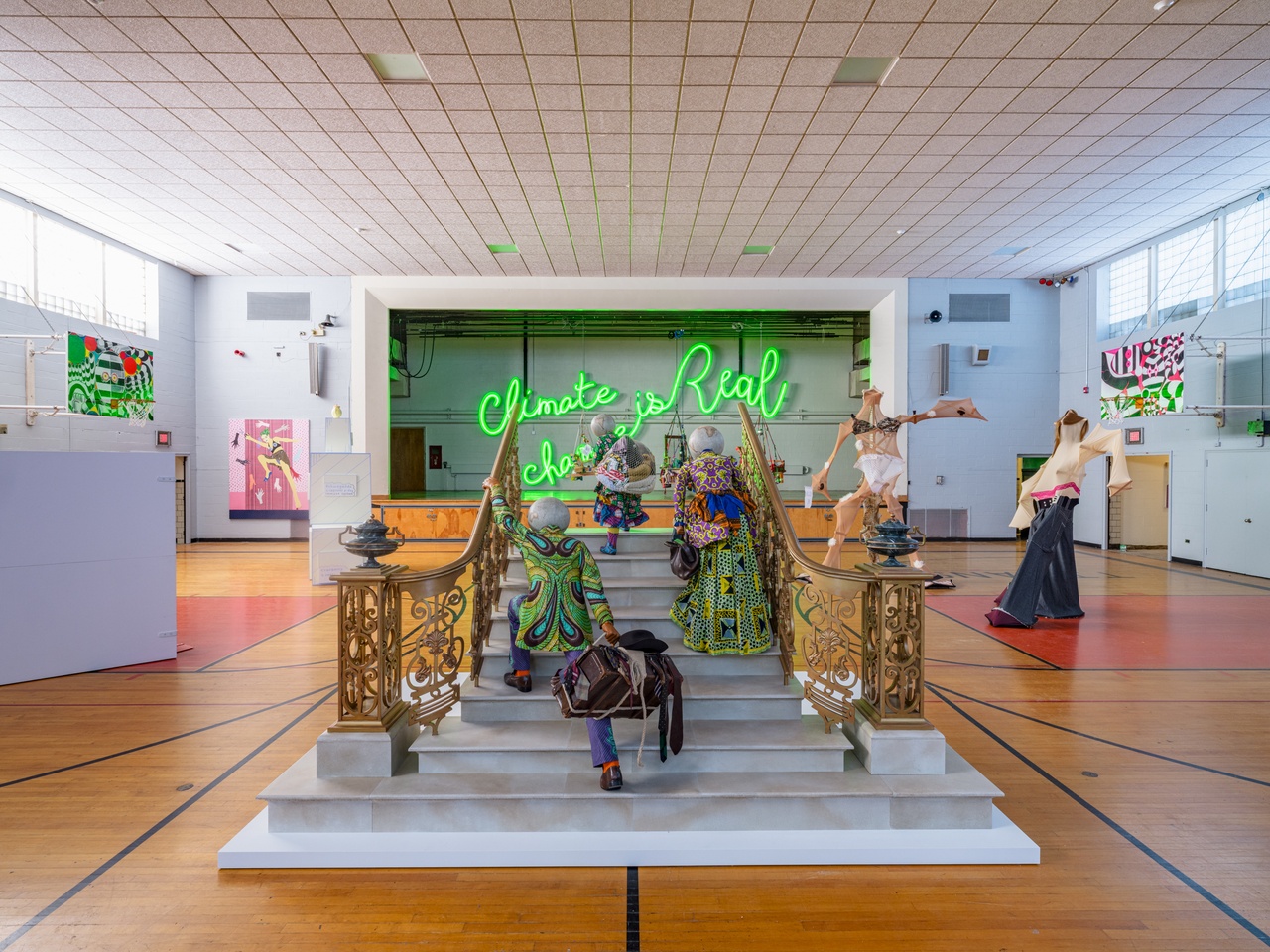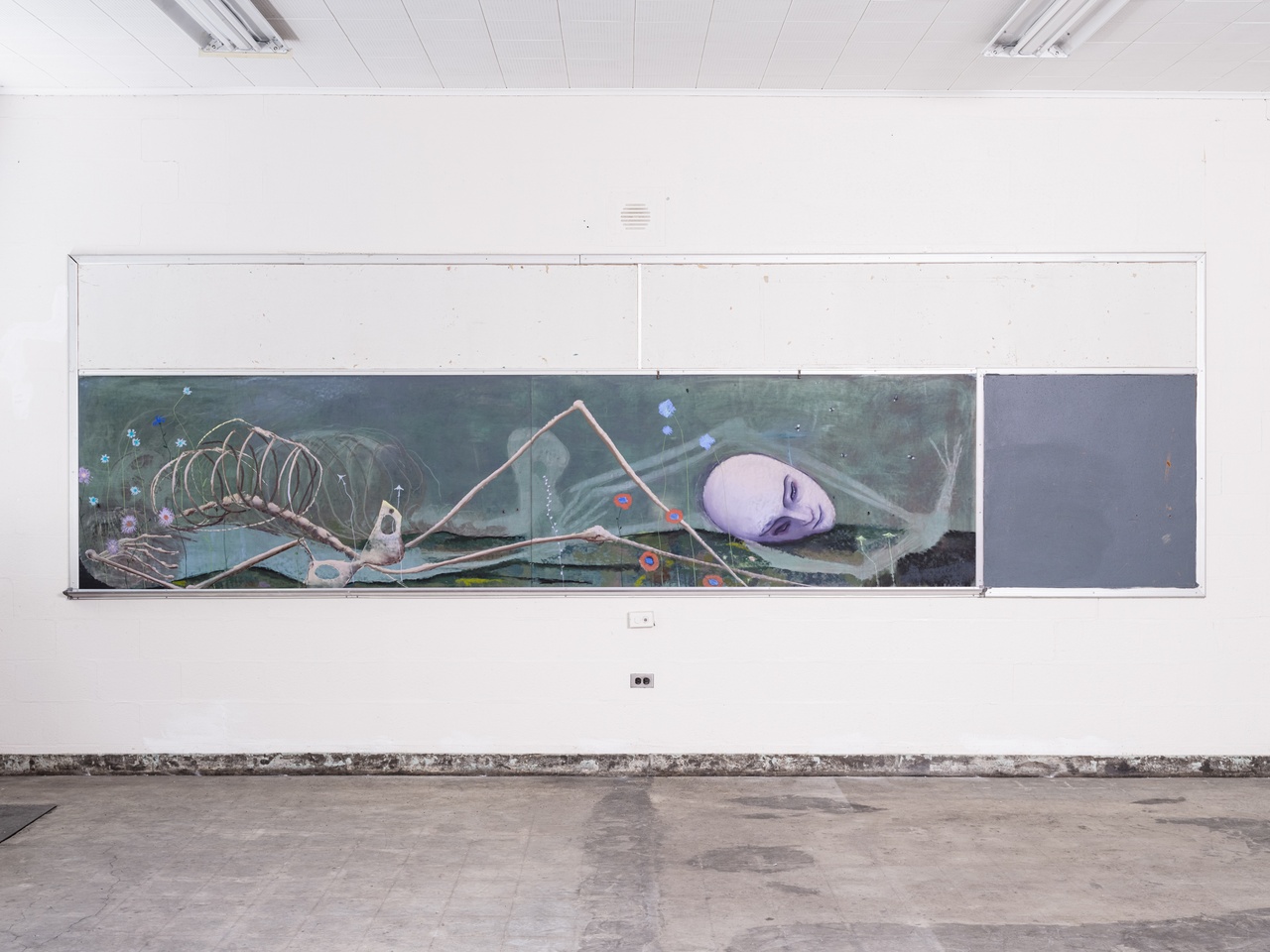COLLECTIVE COURSEWORK Tom McDonough on The Campus, Hudson, NY

Inaugural exhibition at The Campus, Hudson, NY, 2024
The contemporary art market has long been a volatile sector of the economy, prone to swings of boom and bust closely aligned with larger trends in financial markets. The asset bubble of the last 15 years, spurred on by record-low interest rates promulgated by central banks in the wake of the 2008–09 financial crisis, led to a vast expansion of wealth in the uppermost echelons of society and, concomitantly, a practically unprecedented spending spree on luxury commodities, including contemporary artworks. The tightening of credit in the wake of the pandemic – intended to rein in the inflation generated by working-class wage gains – has spurred a retrenchment of this spending, with deep implications for the business of selling art. At the risk of oversimplification, we might note an exacerbation of the churn that has been evident for well over a decade, with money and talent flowing seemingly inexorably upward into a small number of globally branded mega-galleries that are able, thanks to their diversified stables, to better survive these challenging times. Their increasing dominance is gradually squeezing out a formerly rich ecosystem of midrange operations that has been vital to supporting artistic careers, nurturing a collector base, and broadly sustaining that most elusive of social spaces, a contemporary art “community.” While this phenomenon is generalized across Western economies, it has had particular impacts on the New York art world, located as it is in a city that, over the past several decades, has served as a laboratory for remaking the final remnants of public space into new sites for rent extraction and speculative profit.
These large-scale trends are one necessary context for understanding The Campus, a new exhibition venue located in a former public school and its grounds in the Hudson Valley, about two and a half hours north of Manhattan. The project is a collaboration of six well-known New York galleries – Bortolami, James Cohan, kaufmann repetto, Anton Kern, Andrew Kreps, and kurimanzutto – that together purchased the disused property three years ago and have now opened it to the public with a wide-ranging show installed throughout its former auditorium/gymnasium, classrooms, locker rooms, offices, and outdoor campus. If the initial impetus for the purchase seems to have been a need to identify less expensive storage space outside metropolitan New York, it became apparent that the building purchase opened up broader opportunities. Kreps, who along with Cohan initiated the endeavor, has spoken in the press of “a new way of working” that would entail a more collaborative model among these galleries – several of which already share adjacent spaces on Walker Street in Tribeca – rather than the competitiveness that has historically defined the business of selling art. [1] There is a sense of banding together, at least provisionally, to stave off the hulking behemoths of their blue-chip neighbors. “Together we feel stronger: at the same time more competitive and more confident,” Francesca Kaufmann has explained. [2]
If the shifting terrain of the contemporary-art market has partly determined a project such as The Campus, another factor is, of course, real estate itself. Or rather, we should speak of the intersection of the ballooning cost of ground rent in Manhattan and its ever-expanding impact on the region. As noted above, the expense of storage space for gallery inventory was the spur to search for a suitable building outside New York. Cohan and Kreps found a listing for the former Ockawamick High School in 2020, during the pandemic, and then assembled the consortium to purchase it the following summer for $1.2 million – a comparative bargain considering the property encompasses the 78,000-square-foot building as well as over 20 acres of surrounding land. Ockawamick had opened in 1952 to serve the scattered communities of rural southeastern Columbia County, on the east side of the Hudson River about 120 miles north of New York City, and it closed four-and-a-half decades later in the face of declining enrollment and school district consolidation. The county Board of Supervisors purchased it for $1.5 million in 2008, hoping to move their social service provisions out of the increasingly fashionable town of Hudson; local resistance to the plan led to the building sitting largely unused for six years, until it was finally put on the market and sold, at a significant loss, to the interior designer Eleanor Ambos in 2014, who subsequently transformed it into a space to store and present her extensive collection of art and antiques, in collaboration with a local designer. The gallerists purchased the property from her estate the year following her death.

Sanya Kantarovsky, "Regression," 2024
The story of The Campus is inseparable from transformations affecting the Hudson Valley as a whole: its shift from a mostly deindustrialized and rural region to an outpost for New York’s upper middle classes (or, as Jason Farago of The New York Times pungently described them in a recent article, “Brooklyn transplants cosplaying locavore Marie-Antoinette”) priced out of second homes on eastern Long Island. [3] The pandemic only accelerated a trend that had been growing for over 20 years; the Dia Art Foundation’s move to Beacon in 2003 was a harbinger of things to come. Foundations, exhibition spaces, and sculpture parks have been stretching ever farther north since then. Jack Shainman provided a direct precedent for The Campus when he purchased a colonial revival high school from the 1920s in Kinderhook – 15 miles north of the new project – renovating much of its interior into white-cube gallery space and opening it as The School in 2013. Here, too, a search for affordable storage became motivation for a supposedly public amenity that would, conveniently, also offer the possibility of tax deductions for a necessary gallery expense. As much as this is a story of dealers seeking creative ways to survive tectonic shifts in the art market, it is also one of accelerating gentrification, no longer at the scale of individual urban neighborhoods but of entire regions, encompassing metropoles, their suburbs, and now even their far-flung exurbs.
And what of the show itself? While it is touted as having been curated by Timo Kappeller, a former director at Andrew Kreps, who has spoken of installing works that “respond to the psychology of the school,” what one finds across its sprawling spaces is basically an art fair transported to this onetime high school. [4] As with any art fair, one encounters spectacle (Yinka Shonibare’s sculptural installation Moving Up, 2021), rediscoveries (previously unseen hand-painted versions from the early 1980s of Jenny Holzer’s Survival works), incitements to participation (one of William Forsythe’s ongoing series of “Choreographic Objects,” Track Assignment, 2024, located in an unkempt football field), some new commissions (notably, Sanya Kantarovsky’s symbolist pastels, applied directly to a classroom’s blackboards), and a handful of genuinely inspired ensembles (abstract photographs by Barbara Kasten and decorative canvases by Nathalie Du Pasquier look particularly strong as installed in the more intimately scaled spaces of the former principal’s office) amid the lockstep of more-or-less felicitous or inapposite juxtapositions in the many rooms given over to the exhibition, with Kappeller mixing and matching artists from the six galleries along with some extramural invitees. But it is difficult to shake the impression that these front-of-house spaces remain, in a sense, mere window-dressing for the unseen rationale of the entire project: as a stockroom for the inventory of these six galleries and perhaps – as one hears – on a rental basis for others as well. (Notably, only storage areas have been equipped with proper climate control; exhibition spaces will necessarily remain seasonal.)
So what are the lessons to be gleaned from The Campus? Whatever its real merits, the project is a symptom of its moment, determined by the intersection of post-pandemic transformations in the New York art market and in the regional real estate market. One might contrast its ambitions with those announced in another repurposed high school almost 50 years ago, when in spring 1976, Alanna Heiss opened PS1 in Queens with the exhibition “Rooms.” The installations that comprised the show helped to consolidate the emergent practice of site-specificity and inspired the second half of Rosalind Krauss’s seminal essay “Notes on the Index,” published the following year. In it, she described how “the ambition of the works is to capture the presence of the building, to find strategies to force it to the surface into the field of the work.” [5] That reciprocal relationship between text and context, a relationship that impinges critically on both elements, is absent here. The charms of the old Ockawamick High School remain evident, but they serve as little more than a passive stage for the display of objects for sale – even in the case of artists who were tasked with establishing a connection to the building. However beautiful Kantarovsky’s pastel-on-blackboard works may be, they use their found supports merely to provide qualities of scale and surface; there is no meaningful engagement with site. The gap between the amenity of public education, in all its midcentury optimism, and the privatized pleasures of the leisure class being attended to here is never productively mobilized and only serves to remind the visitor of the more cramped ambitions of our own time.
Tom McDonough is an art historian, critic, and professor at Binghamton University, State University of New York. He is the author of several books on art and cultural theory.
Inaugural exhibition, The Campus, Hudson, NY, June 29–October 27, 2024.
Image credit: 1. + 2. Photos Yael Eban and Matthew Gamber
Notes
| [1] | Andrew Kreps, quoted in Laura van Straaten, “Abandoned School Becomes New Home for Art,” New York Times, May 15, 2024, C5. |
| [2] | Francesca Kaufmann, quoted in Stephanie Sporn, “The Campus, a Collaboration Between Six New York Galleries, Is the Hudson Valley’s Latest Art Destination,” Vogue, July 5, 2024. |
| [3] | Jason Farago, “Put the Museum Mile in the Rearview,” New York Times, August 30, 2024, C1. |
| [4] | Kreps, quoted in Sporn, “The Campus.” |
| [5] | Rosalind Krauss, “Notes on the Index: Seventies Art in America,” October, no. 3 (Autumn 1977): 65. |

